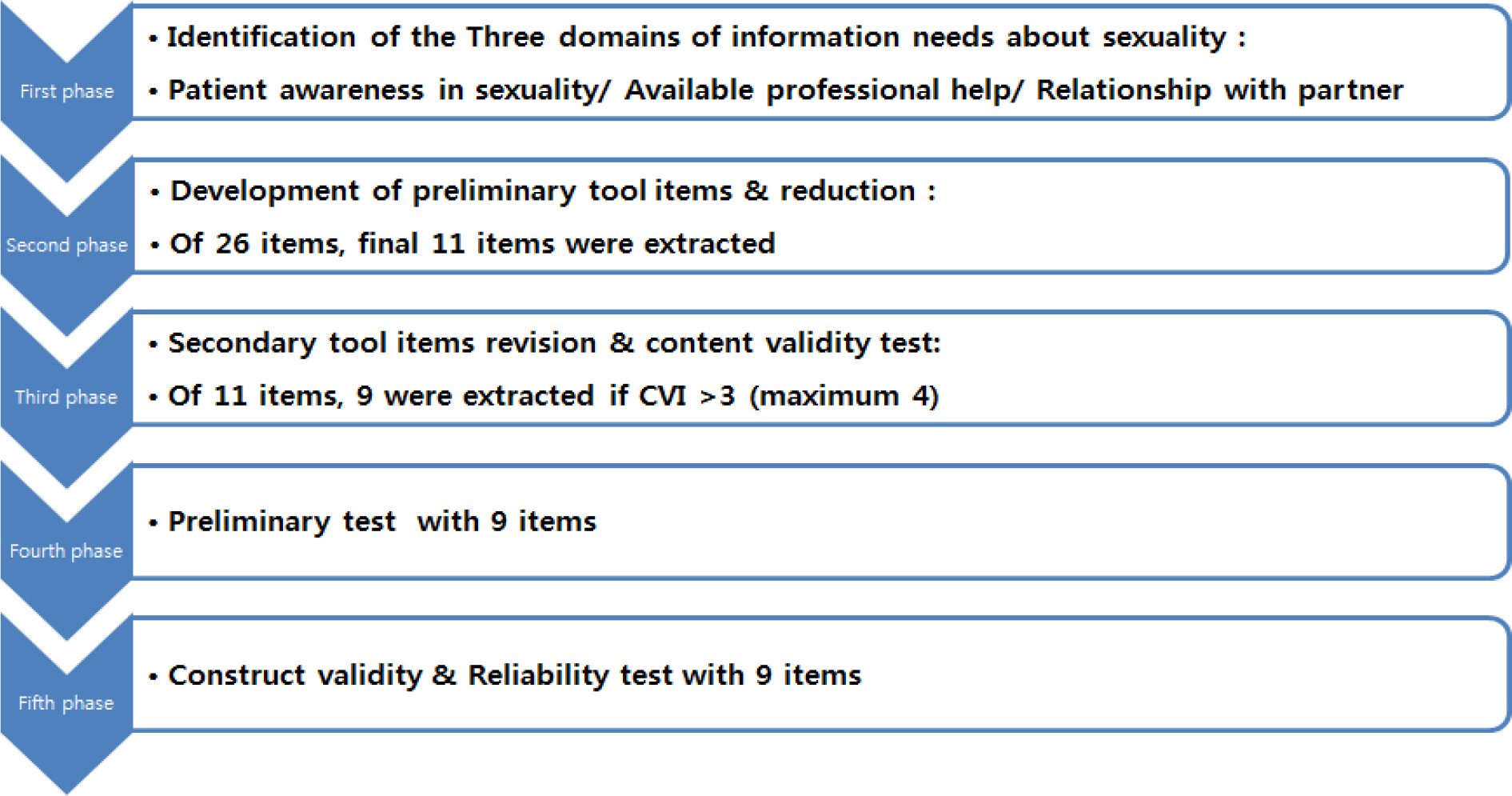Korean J Women Health Nurs.
2015 Sep;21(3):207-215. 10.4069/kjwhn.2015.21.3.207.
Tool Development for Cancer Patients' Sexuality Information Needs
- Affiliations
-
- 1Division of Nursing, Asan Medical Center, Seoul, Korea.
- 2College of Nursing, Seoul National University, Seoul, Korea. haewon@snu.ac.kr
- 3The Research Institute of Nursing Science, Seoul National University, Seoul, Korea.
- 4Department of Nursing, Catholic Kwandong University, Gangreung, Korea.
- KMID: 2307917
- DOI: http://doi.org/10.4069/kjwhn.2015.21.3.207
Abstract
- PURPOSE
This study aimed to develop a scale measuring sexuality information needs of patients with cancer.
METHODS
Nine items of sexuality information needs were based on the PLISSIT model and concepts of sexual rights. A factor analysis using principal axis factoring and Cronbach's alpha were performed to test validity and reliability. Data were collected from 211 patients with cancer visiting a cancer center in Seoul, Korea.
RESULTS
Factor loadings of the 9 items of sub scales ranged from .43 to .96. Three factors in this study explained 74.4% of the total variance. Cronbach's alpha of the 9 items was .83.
CONCLUSION
The scale of information needs about sexuality showed acceptable construct validity and reliability. This scale would be useful to assess the levels of information needs for sexuality for patients with cancer. The possibility of the scales' expansion to other group could be investigated in future studies.
Keyword
MeSH Terms
Figure
Reference
-
1. World Association for Sexual Health. Sexual health for the millenium. A declaration and technical document [Internet]. Minneapolis, MN: World Association for Sexual Health;2008. [cited 2012 October 23]. Available from:. http://176.32.230.27/worldsexology.org/wp-content/up-loads/2013/08/millennium-declaration-english.pdf.2. Kim HW, Im ES, Kim NS. Development and application of sexual rights awareness scale for female adults. Korean Journal of Women Health Nursing. 2010; 16(1):69–77.
Article3. Reynolds KE, Magnan MA. Nursing attitudes and beliefs toward human sexuality: Collaborative research promoting evidence-based practice. Clinical Nurse Specialist. 2005; 19(5):255–259.4. Katz A. The sounds of silence: Sexuality information for cancer patients. Journal of Clinical Oncology. 2005; 23(1):238–241.
Article5. Katz A. Breaking the silence on cancer and sexuality: A handbook for healthcare providers. Sexuality and Disability. 2008; 26(2):115–116.6. Southard NZ, Keller J. The importance of assessing sexuality: A patient perspective. Clinical Journal of Oncology Nursing. 2009; 13(2):213–217.
Article7. Kim HW, Jung YY, Park S. Evaluation and application of the Korean version of the sexuality attitudes and beliefs survey for nurses. Journal of Korean Academy of Nursing. 2012; 42(6):889–897.
Article8. Kim S, Kang HS, Kim JH. A sexual health care attitude scale for nurses: Development and psychometric evaluation. International Journal of Nursing Studies. 2011; 48(12):1522–1532.
Article9. Zeng YC, Liu X, Loke AY. Addressing sexuality issues of women with gynaecological cancer: Chinese nurses’ attitudes and practice. Journal of Advanced Nursing. 2012; 68(2):280–292.
Article10. Algier L, Kav S. Nurses' approach to sexuality related issues in patients receiving cancer treatment. Turkish Journal of Cancer. 2008; 38(3):135–141.11. Julien JO, Thom B, Kline NE. Identification of barriers to sexual health assessment in oncology nursing practice. Oncology Nursing Forum. 2010; 37(3):E186–E190.
Article12. Rutten LJF, Arora NK, Bakos AD, Aziz N, Rowland J. Information needs and sources of information among cancer patients: A systematic review of research (1980-2003). Patient Education and Counseling. 2005; 57(3):250–261.
Article13. Zebrack B. Information and service needs for young adult cancer patients. Supportive Care in Cancer. 2008; 16(12):1353–1360.
Article14. Hill EK, Sandbo S, Abramsohn E, Makelarski J, Wroblewski K, Wenrich ER, et al. Assessing gynecologic and breast cancer survivors' sexual health care needs. Cancer. 2011; 117(12):2643–2651.
Article15. World Health Organization. Sexual and reproductive health [Internet]. World Health Organization. 2015. [cited 2015 February 10]. Available from:. http://www.who.int/reproductivehealth/topics/sexual_health/conceptual_elements/en/.16. Annon JS. The behavioral treatment of sexual problems. Honolulu: Kapiolani Health Services;1974.17. Dipankar B. Different types of information needs with special reference to GIMT, AZARA, GUWAHATI [Internet]. Acade-mia. 2015. [cited 2015 February 10]. Available from:. http://www.academia.edu/3727858/Different_types_of_Information_needs_with_special_reference_to_GIMT_AZARA_GUWAHATI.18. Kang H. A guide on the use of factor analysis in the assessment of construct validity. Journal of Korean Academy of Nursing. 2013; 43(5):587–594.
Article19. DiGiulio S. Discussing unmet sexual health needs with cancer patients. Oncology Times. 2014; 36(14):46–47.
Article20. Gilbert E, Perz J, Ussher JM. Talking about sex with health professionals: The experience of people with cancer and their partners. European Journal of Cancer Care. Forthcoming 2014 Jul 10.
- Full Text Links
- Actions
-
Cited
- CITED
-
- Close
- Share
- Similar articles
-
- Application of Evaluation Criteria for Web sites to Sexuality Education
- Development and Application of Evaluation Tool for Sexuality Education in Elementary School
- School Health and Sexuality Education
- Perceptions of Sexuality in Unmarried Mothers
- Knowledge, Attitudes, and Educational Needs for Sexuality of the Elderly


